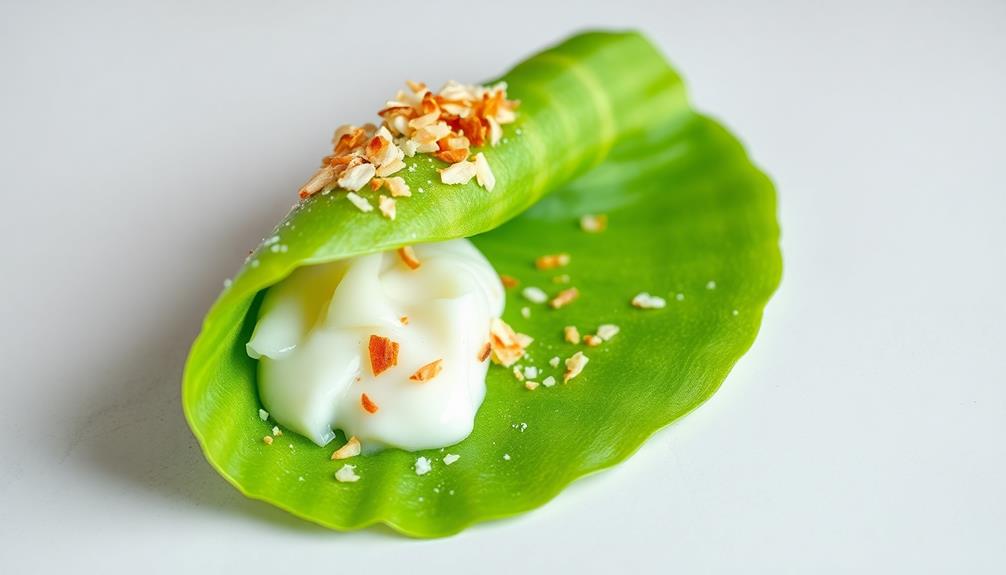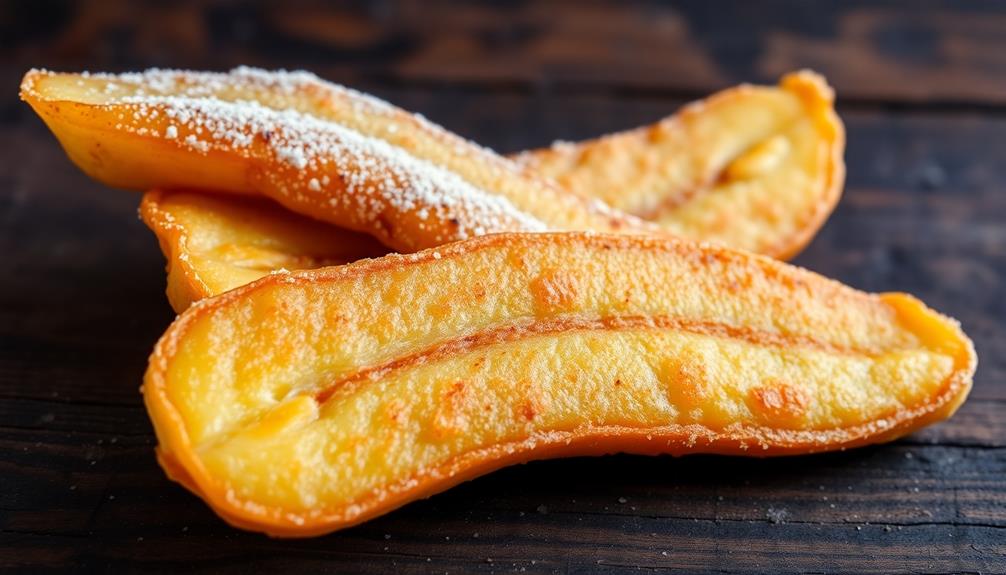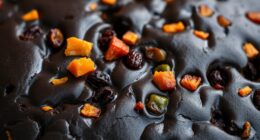You're in for a real treat with Dadar Gulung, Indonesia's scrumptious pandan crepes! These vibrant green, pandan-infused pancakes are filled with a divine mixture of sweet coconut and palm sugar. Originated centuries ago from the culinary masters of Java, Dadar Gulung has become a beloved cultural staple across the Indonesian archipelago. Bursting with fragrant aromas and a soft, chewy texture, each bite transports you to the tropical landscapes of Indonesia. Whether enjoyed during celebrations or as a daily indulgence, these pandan crepes are sure to delight your senses. And if you keep reading, you'll uncover the captivating history and mouthwatering recipe behind this iconic Indonesian dessert.
Key Takeaways
- Dadar Gulung is a traditional Indonesian dessert made from pandan-flavored crepes, often filled with a sweet coconut and palm sugar mixture.
- The dish has a rich cultural heritage, originating from the Javanese people and representing Indonesia's diverse culinary traditions.
- The vibrant green color of Dadar Gulung is derived from the use of pandan leaves, symbolizing the country's lush tropical landscapes.
- Dadar Gulung is a cherished dish, served during celebrations and family gatherings, and reflects the use of local ingredients and sustainable cooking methods.
- The flavor profile of Dadar Gulung balances the sweetness of palm sugar and the savory notes of coconut, creating a unique and aromatic experience.
History
Dadar Gulung, a beloved Indonesian dessert, has a rich history that dates back centuries. This delightful pandan-flavored crepe was originally created by the Javanese people, who were renowned for their expertise in the culinary arts.
Over time, the recipe for Dadar Gulung spread throughout the Indonesian archipelago, becoming a beloved treat enjoyed by people of all ages.
The name "Dadar Gulung" translates to "rolled pancake" in the Indonesian language, reflecting the dish's distinctive shape and preparation method. The pandan leaves, which impart the crepe's vibrant green hue and unique flavor, were likely incorporated into the recipe as a nod to the lush, tropical landscapes of Indonesia. The filling of Dadar Gulung is traditionally made from grated coconut and palm sugar, creating a sweet and satisfying combination. The dish is often enjoyed as a dessert or snack, with its delicate sweetness and refreshing pandan flavor making it a popular choice for locals and visitors alike. In addition to Dadar Gulung, another classic Indonesian dish that showcases the use of pandan leaves is the siomay recipe, which pairs steamed fish dumplings with a flavorful peanut sauce.
Today, Dadar Gulung remains a cherished part of Indonesian culture, with families passing down the recipe from generation to generation.
Whether enjoyed as a snack or a dessert, this delectable creation continues to delight and inspire culinary enthusiasts around the world.
Recipe
Dadar Gulung is a delicious Indonesian pancake often enjoyed as a snack or dessert. The name "Dadar Gulung" translates to "rolled pancake" in English. This traditional treat features a soft, pandan-flavored pancake wrapped around a sweet coconut filling.
The pandan leaf, a fragrant tropical plant, is the key ingredient that gives Dadar Gulung its distinct green color and unique flavor profile. Pandan leaves are commonly used in Southeast Asian cuisine to infuse dishes with a subtle, nutty aroma.
- 250 grams all-purpose flour
- 2 eggs
- 400 ml coconut milk
- 1 teaspoon pandan extract
- 1/4 teaspoon salt
- 100 grams shredded coconut
- 100 grams palm sugar, grated
- 1/4 teaspoon salt
In a large bowl, whisk together the flour, eggs, coconut milk, pandan extract, and salt until a smooth batter forms.
Heat a lightly oiled non-stick pan over medium heat. Pour about 1/4 cup of the batter into the pan, swirling to coat the bottom. Cook for 2-3 minutes until the pancake is set and can be easily flipped.
Repeat with the remaining batter, stacking the cooked pancakes on a plate.
For the filling, combine the shredded coconut, palm sugar, and salt in a bowl. Place a heaping tablespoon of the coconut mixture onto the center of each pancake, then roll it up tightly.
Serve the Dadar Gulung warm, and enjoy the contrast between the soft, pandan-infused pancake and the sweet coconut filling.
Cooking Steps
First, you'll make a simple batter with flour, eggs, and milk.
Next, heat up a pan and pour the batter onto it, spreading it evenly.
Finally, roll up the delicate crepe into a satisfying cylinder.
Get ready to whip up some tasty Dadar Gulung!
Step 1. Make Batter With Flour, Eggs, and Milk
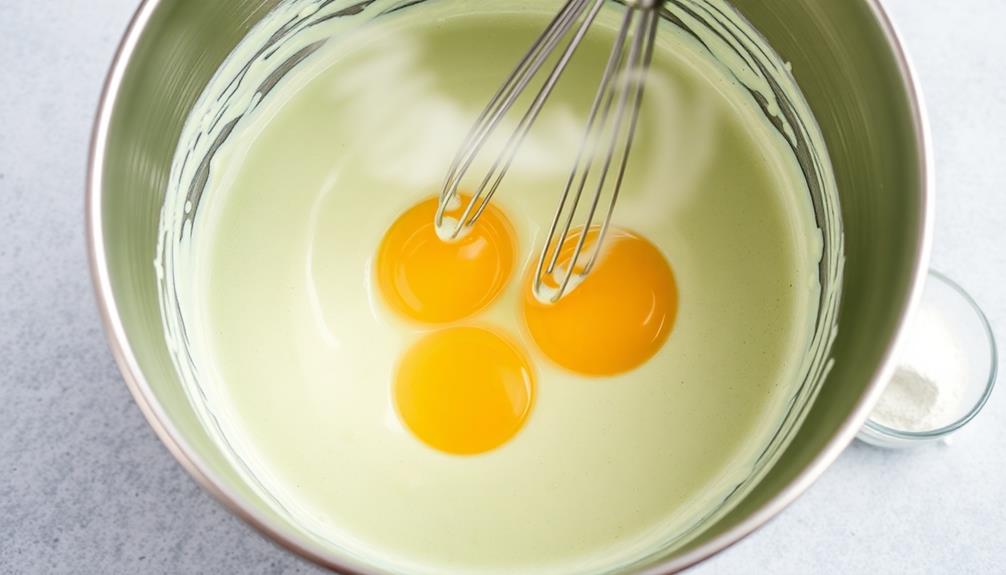
To create the batter, gather flour, eggs, and milk in a mixing bowl. Add 1 cup of all-purpose flour and whisk it together. Then, crack 2 large eggs into the bowl and pour in 1 cup of milk. Whisk the mixture vigorously until it becomes smooth and lump-free. You want the batter to have a pourable, pancake-like consistency.
Next, stir in 1 tablespoon of granulated sugar and a pinch of salt. The sugar adds a touch of sweetness, while the salt enhances the overall flavor. Be sure to mix everything thoroughly until well combined.
Finally, cover the bowl and let the batter rest for 30 minutes. This resting period allows the flour to fully hydrate, resulting in a light and airy crepe.
Now you're ready to start cooking your delicious Dadar Gulung! Heat a non-stick pan over medium heat and lightly grease it with oil or butter. Pour in a small amount of batter and swirl the pan to create a thin, even layer. Cook until the crepe is golden brown on the bottom, then gently flip and cook the other side.
Step 2. Heat the Pan
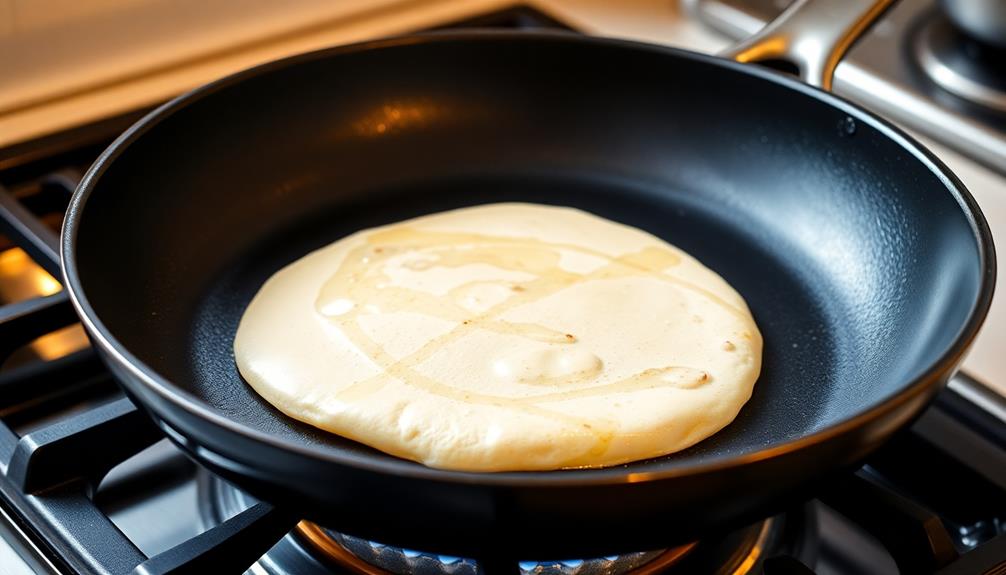
Once the batter is ready, heat a non-stick pan over medium heat and lightly grease it with a small amount of oil or butter.
You'll want to ensure the pan is hot enough, but not too hot, to prevent the crepes from burning or sticking.
Gently pour a small amount of batter onto the center of the pan, swirling it around to create a thin, even layer.
Cook the crepe for about a minute, or until the edges start to lift and the center is set.
Carefully use a spatula to lift one edge of the crepe, then quickly flip it over to cook the other side for an additional 30 seconds to a minute.
The crepe should be lightly golden and pliable when done.
Slide the cooked crepe onto a plate and repeat the process, pouring more batter and cooking each crepe one at a time.
Be sure to re-grease the pan lightly between each crepe to prevent sticking.
Soon, you'll have a stack of delicious pandan-flavored crepes ready to be filled and rolled.
Step 3. Pour Batter Onto Pan

With the pan heated, you can now pour a small amount of the batter onto the center of the pan. Gently tilt the pan to allow the batter to spread out in a thin, even layer.
Be careful not to pour too much, as you want a delicate, lacy crepe rather than a thick pancake.
As the batter begins to sizzle, watch it closely. When the edges start to turn golden and the center is no longer shiny, it's time to flip the crepe.
Slide a spatula under the crepe and gently lift one edge, then flip the entire crepe over. Cook the other side for a minute or so, until it's also lightly golden.
Once both sides are cooked, slide the crepe onto a plate.
Repeat this process, pouring and flipping, until you've used up all the batter. Remember to adjust the heat as needed to prevent the crepes from burning or becoming too dark.
Step 4. Spread the Batter Evenly
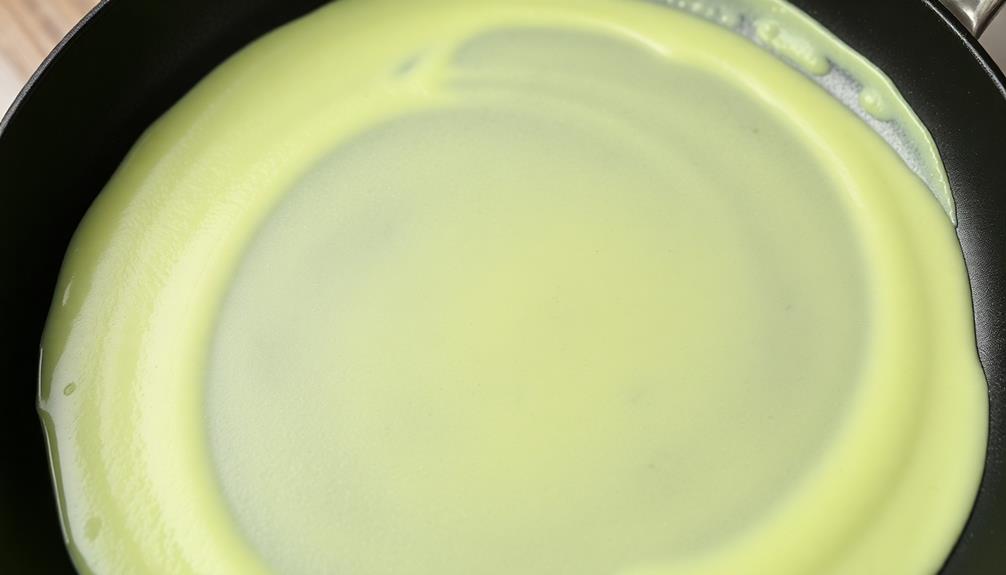
Gently tilt the pan to spread the batter into a thin, even layer. Use a circular motion, making sure to reach the edges of the pan. This will ensure the crepe cooks evenly, with no thin or thick spots.
Once the batter is spread, let it cook for about a minute, until the edges start to dry and curl slightly.
Now, take a spatula and gently lift the edges of the crepe to check if it's ready to flip. If it's nicely browned on the bottom, it's time to flip it over.
Carefully slide the spatula under the crepe and flip it in one smooth motion. Let the other side cook for another 30 seconds to a minute, until it's also lightly browned.
Step 5. Roll up the Crepe
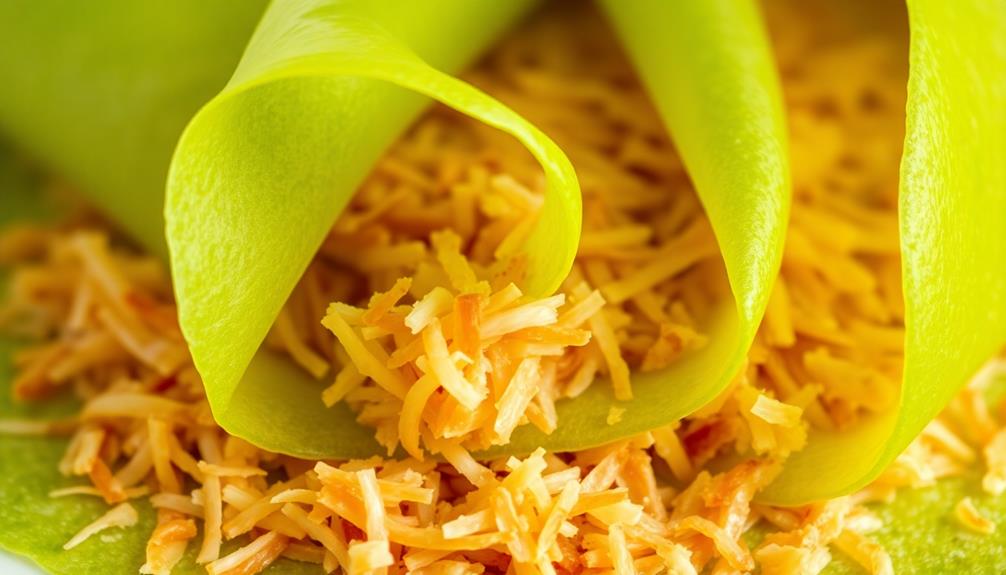
After you've successfully flipped the crepe, you'll want to start rolling it up. Gently slide your spatula under the crepe to loosen it from the pan. Then, use your fingers to carefully lift one edge of the crepe and begin rolling it up tightly.
Roll the crepe into a tight cylinder, making sure to keep it compact as you go. Once the crepe is fully rolled up, you can transfer it to a plate. If the crepe sticks to the pan, don't worry – simply use your spatula to gently coax it free.
As you roll up each crepe, place it seam-side down on the plate to help it hold its shape. Continue this process until you've rolled up all the crepes.
Be gentle and take your time – the key is to roll them up tightly without tearing the delicate pandan-flavored dough. With a little practice, you'll be rolling up perfect dadar gulung crepes in no time!
Final Thoughts
Having explored the delightful world of Dadar Gulung, you can't help but appreciate its unique blend of flavors and textures. The vibrant pandan leaves infuse the crepe with a captivating aroma, while the sweet coconut filling provides a delightful contrast. The way the crepe effortlessly rolls up, revealing the hidden treasure inside, is truly mesmerizing.
As you savor each bite, you're struck by the harmonious combination of the soft, delicate crepe and the rich, creamy filling. The pandan's earthy notes balance the sweetness, creating a well-rounded flavor profile that lingers on your taste buds.
It's a testament to the skill and artistry of Indonesian cuisine, where every element is carefully considered to achieve a perfect equilibrium.
Dadar Gulung isn't just a delectable treat; it's a culinary experience that celebrates the vibrant culture and traditions of Indonesia. Indulging in this delightful creation is a journey worth savoring, each bite a delightful discovery.
Frequently Asked Questions
Can I Substitute Pandan Leaves With Artificial Flavoring?
You can substitute pandan leaves with artificial flavoring, but it won't provide the same authentic taste and aroma. The natural pandan essence is essential for capturing the true essence of the dish.
How Can I Make the Crepe Extra Crispy?
To make the crepe extra crispy, you can use a thin batter, preheat the pan thoroughly, and cook the crepe until golden brown on both sides. Avoid overcrowding the pan, and let the crepe cook undisturbed for a crisp texture.
Is It Possible to Freeze the Batter for Future Use?
You can definitely freeze the batter for future use. Just pour it into an airtight container or ziplock bag, and when you're ready to use it, thaw it in the fridge overnight. The frozen batter will keep for up to 3 months.
Can I Use Different Fillings Besides the Traditional Coconut?
You can absolutely use different fillings besides the traditional coconut. Get creative with sweet or savory options like chocolate, cheese, or even vegetables. The possibilities are endless when it comes to making these delightful crepes your own.
How Long Can the Cooked Crepes Be Stored Before Serving?
The cooked crepes can be stored for up to 3 days in the refrigerator before serving. Just be sure to wrap them tightly in plastic wrap or place them in an airtight container to keep them fresh.
